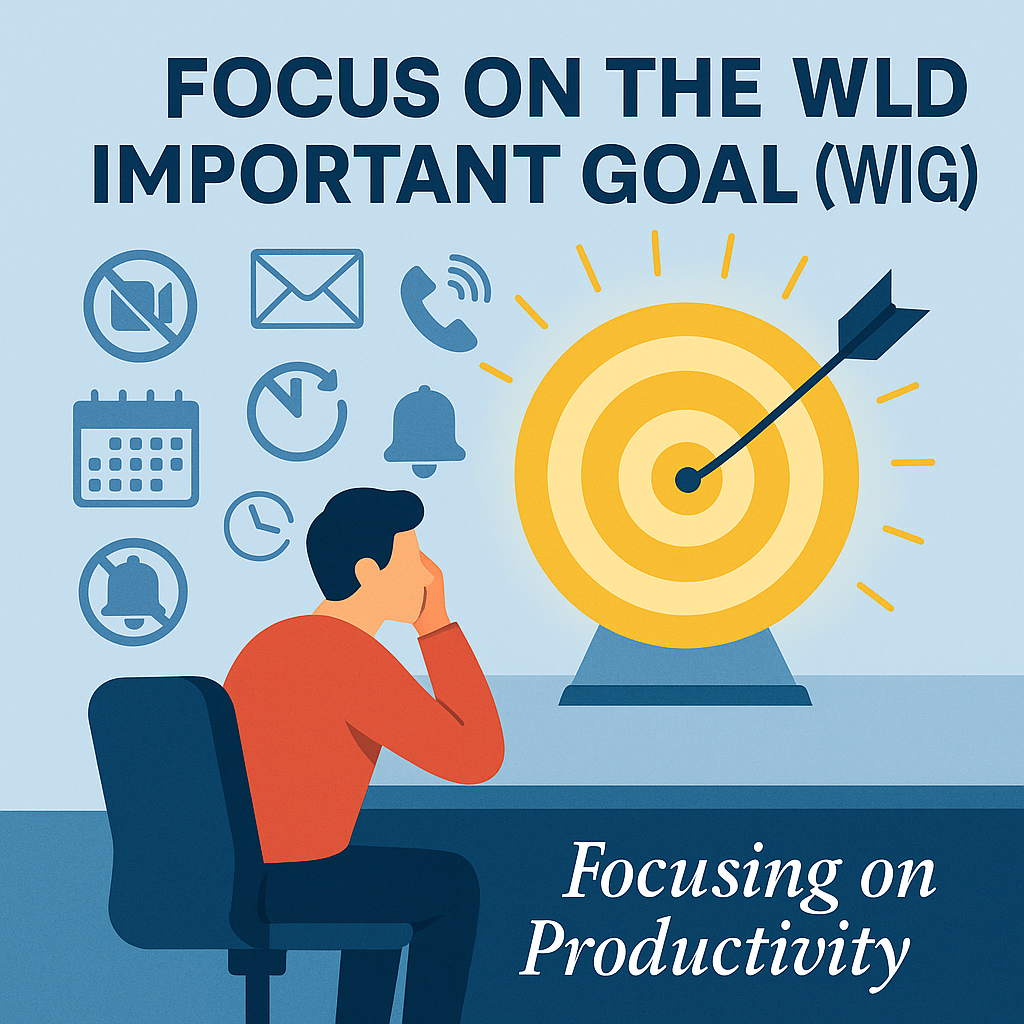One of the biggest enemies of productivity is distraction—not just from external sources, but from having too many priorities. In today’s fast-paced world, where multitasking is celebrated and “being busy” is mistaken for effectiveness, the real key to high performance lies in something surprisingly simple: focusing on what matters most.
This principle is at the core of the first discipline in the 4DX framework: Focus on the Wildly Important Goal (WIG). In this article, we’ll explore why focusing on the crucial few—rather than the trivial many—is essential to sustainable productivity and execution.
Why Focus Matters More Than Ever
You might be working all day but feel like you’re not really achieving anything meaningful. This is often because you’re caught in the whirlwind—the urgent but non-strategic tasks that dominate your time.
The discipline of focus helps you:
- Clarify what truly matters
- Direct energy and resources efficiently
- Prevent burnout from task overload
- Gain momentum toward long-term goals
Without focus, even your best intentions get buried under emails, meetings, and minor tasks.
The Trap of Too Many Priorities
Contrary to popular belief, you can’t prioritize everything. A goal loses power the moment you treat multiple things as equally important.
Studies in neuroscience show that the human brain isn’t wired for multitasking. It switches between tasks, which reduces effectiveness and increases fatigue.
When you split your attention among 5 or 6 goals, progress is slow and motivation fades. But when you zero in on one Wildly Important Goal, you create a laser-like focus that drives real results.
The Power of One Goal
By choosing just one WIG, you remove ambiguity. Everyone on your team—or just you, if you’re working solo—knows exactly what the top priority is.
Benefits of a singular focus:
- Clear decision-making
- Measurable progress
- Stronger motivation
- Reduced overwhelm
- Quicker learning from results
It also becomes easier to communicate your priorities to others, and to align your daily actions with your long-term objectives.
How to Identify Your Wildly Important Goal
Not every task is a candidate for your WIG. Here’s how to pick a truly high-impact goal:
- Ask yourself: What’s the one result that would make everything else easier or unnecessary?
- Look for bottlenecks or weak areas that, if improved, would cause a domino effect in other areas.
- Choose something you can influence directly—a goal that depends primarily on your actions.
Example:
If you’re an online entrepreneur, a WIG could be:
“Grow email subscriber list from 1,000 to 3,000 in the next 90 days.”
This goal is measurable, time-bound, and strategically crucial.
The Role of Leadership in Focus
If you’re managing a team, focus starts with you. Leaders who try to pursue too many objectives at once create confusion and dilute effort.
To build a culture of focus:
- Communicate the WIG clearly and frequently.
- Align team tasks around the WIG.
- Say no to good ideas that don’t support the WIG—for now.
It takes courage to say “not yet” to many things in order to say “absolutely” to the one that matters most.
Aligning Daily Tasks With the WIG
Once your WIG is defined, every task you do should be filtered through this question:
“Does this contribute to my Wildly Important Goal?”
If not, it’s either a distraction or a candidate for delegation.
Practical tips:
- Start your day by reviewing your WIG.
- Use a planner or task manager to block time for WIG-related actions.
- End each week by reviewing your progress on the WIG—not just your to-do list.
This alignment between strategic goals and daily execution is the heartbeat of real productivity.
Tools That Help You Stay Focused
You don’t need fancy apps to maintain focus, but the right tools can help reinforce your discipline.
- Digital tools: Trello, Notion, Todoist
- Analog options: Bullet journals, habit trackers, physical whiteboards
- Accountability systems: Weekly reviews, coaching calls, team check-ins
Choose tools that match your work style and make your WIG visible and central to your workflow.
The Emotional Impact of Focusing on What Matters
Focusing on the Wildly Important doesn’t just improve results—it reduces stress and improves your sense of purpose.
When you always feel behind or scattered, it’s emotionally draining. But when your energy is directed toward a single meaningful goal, you feel empowered. You see real progress. You feel control.
That feeling creates momentum, and momentum leads to breakthrough performance.
Real-Life Example: From Overwhelmed to Productive
Let’s say you’re a content creator trying to grow your platform. At first, you’re doing everything—writing, posting, editing, managing social media, replying to comments.
You decide to focus on one WIG:
“Publish one high-quality article per week for 12 weeks straight.”
Now your week has structure. You say no to unnecessary tasks. You build systems for writing and publishing. You track your progress weekly.
As a result, your output improves, your audience grows, and your stress level drops.
Focus Is the Ultimate Productivity Strategy
If you feel overwhelmed or stuck, don’t try to do more. Try doing less—but better. Focus on the Wildly Important. Let that one goal shape your schedule, actions, and decisions.
By eliminating the noise and doubling down on what matters most, you reclaim your time, energy, and momentum.
So, what’s your Wildly Important Goal? Identify it—and make it your north star starting today.
